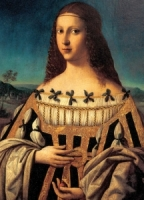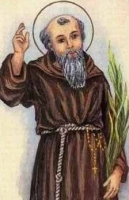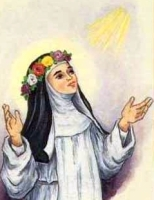Blessed Andrés de Peschiera Grego
Also known as
• Andrés Gregho
• Andrés of Peschiera
• Andrew...
• Apostle of the Valtellina
Profile
Raised in a pious family, Andrés grew up on the shore of Lake Garda in Italy. He early felt a desire to become a hermit, and tried living in monastic style at his father‘s home. When his father died, the 15 year old Andrew joined the Dominicans at the priory at Brescia, Italy. Studied at the San Marco monastery in Florence, Italy with Saint Antoninus of Florence, Blessed Lawrence of Riprafratta, Blessed Constantius of Fabriano, and Blessed Antony della Chiesa. Priest. Travelling preacher in the Valtellina region of Italy, and the areas of Switzerland where the Albigensian heresy had taken root; he worked in the area for 45 years, travelling the mountains on foot, staying with the poor, staying where he could, hiding from bandits and heretics, living off whatever came to hand. Among the parishes, churches, hospitals, schools, orphanages and monasteries he founded was the convent at Morbegno, Italy which became a base of operations for Dominicans trying to bring the people back to orthodox Christianity, and where Andrés retired to spend his final years as a prayerful monk.
Born
1400 in Peschiera del Garda, Italy
Died
• 18 January 1485 in the Dominican convent at Morbegno, Sondrio, Lombardy, Italy of natural causes
• buried at the parish church in Morbegno
• miracles reported at his tomb
• the number of pilgrims who came to it caused the friars to relocate his relics twice, each time to a place with easier access
Beatified
26 September 1820 by Pope Pius VII (cultus confirmation)
Representation
book with a snake emerging from the pages; it refers to a report of a miracle in which Albegensian heretics brought Andrés a book that they said would explain their beliefs; he told them to open it; a serpent emerged from the pages, the heretics saw the error of their ways, and converted back to orthodox Christianity
Blessed Maria Teresa Fasce
Profile
Taught catechetism to children. She grew to love Augustinian spirituality, and became acquainted with the human and spiritual adventure of Rita of Cascia, whose canonization in 1900 was very special to Maria, leading to her desire to be an Augustinian religious in the monastery of Cascia, Italy. She entered in June 1906 at age 25, made her initial vows on Christmas 1907, taking the name Maria Teresa.
The community was in sad decline when Maria Teresa entered, and she became disillusioned. In 1911, she stayed her family for a period of reflection, but returned to the convent, taking her solemn vows on 22 March 1912. Novice mistress in 1914. After writing letters about the terrible spiritual condition of the community, she was appointed vicar from 1917 to 1920, and abbess from 1920 till her death in 1947.
The little chapel containing Saint Rita's body was almost unknown when Mother Maria entered the monastery. Today the basilica is a place of pilgrimage for thousands who learned of Rita through the pamphlet, Dalle Api alle Rose, which Mother Maria started in 1923. Mother Maria's dream was to bring people to God through Saint Rita - and it has worked.
The monastery took in orphan girls, and many live in the modern "Saint Rita's Hive" next to the church. An Augustinian seminary, a hospital, retreat house, and other services grew up around the chapel. Mother Maria Teresa's love was the cause of it all, her spirit sustaining her frail body through the years and work.
Born
27 December 1881 at Torriglia, Genoa, Italy as Maria Fasce
Died
• 18 January 1947 of natural causes
• buried next to Saint Rita of Cascia
Beatified
12 October 1997 by Pope John Paul II
Saint Margaret of Hungary
ஹங்கேரியின் புனிதர் மார்கரெட்
துறவி/ கன்னியர்:
பிறப்பு: ஜனவரி 27, 1242
க்ளிஸ் ஃபோர்ட்ரெஸ், க்ளிஸ், குரோஷியா அரசு
இறப்பு: ஜனவரி 18, 1271 (வயது 28)
நியுலக் ஸ்ஸிகெட், ஹங்கேரி அரசு
ஏற்கும் சமயம்:
ரோமன் கத்தோலிக்க திருச்சபை
முக்திபேறு பட்டம்: ஜூலை 28, 1789
திருத்தந்தை ஆறாம் பயஸ்
புனிதர் பட்டம்: நவம்பர் 19, 1943
திருத்தந்தை பன்னிரெண்டாம் பயஸ்
நினைவுத் திருநாள்: ஜனவரி 18
புனிதர் மார்கரெட், ஒரு கன்னியரும், “டொமினிக்கன்” (Dominican nun) சபையைச் சேர்ந்த அருட்சகோதரியும் ஆவார். இவர், “ஹங்கேரி” (Hungary) நாட்டின் அரசனான “நான்காம் பேலாவின்” (King Béla IV) மகள் ஆவார். இவரது தாயாரின் பெயர், “மரியா லஸ்கரீனா” (Maria Laskarina) ஆகும். இவர், “போலந்தின் புனிதர் கிங்கா” (St. Kinga of Poland), மற்றும் “போலந்தின் அருளாளர் யோலந்தா” (Blessed Yolanda of Poland) ஆகியோரின் சகோதரியாவார். இவர், புகழ்பெற்ற “ஹங்கேரியின் புனிதர் எலிசபெத்தின்” (Saint Elizabeth of Hungary) சகோதரரின் மகள் (மருமகள்) ஆவார்.
மார்கரெட், “குரோஷியா அரசின்” (Kingdom of Croatia) “க்ளிஸ் ஃபோர்ட்ரெஸ்” (Klis Fortress) எனுமிடத்தில் அரச தம்பதியினருக்கு எட்டாவது - கடைசி மகளாகப் பிறந்தார். அவர்கள், கி.பி. 1241–42 ஆண்டு காலத்தில், “மங்கோலியர்களின் ஹங்கேரி மீதான படையெடுப்பின்போது” (Mongol invasion of Hungary) வாழ்ந்தவர்களாவர். அவர்களது தந்தை அந்நாட்டின் அரசராதலால், மங்கோலியர்களிடமிருந்து ஹங்கேரி விடுவிக்கப்பட்டால், அவர்கள் தமது குழந்தையை ஆன்மீகத்திற்கு அர்ப்பணிப்பதாக அவரது பெற்றோர் உறுதிமொழியேற்றனர்.
மூன்று வயதான மார்கரெட், கி.பி. 1245ம் ஆண்டு, “வெஸ்ப்ரெம்” (Veszprém) எனுமிடத்திலுள்ள டொமினிகன் மடாலயத்திற்கு தனது பெற்றோரால் ஒப்படைக்கப்பட்டார். ஆறு வருடங்கள் கழித்து, ஒன்பது வயதான குழந்தை மார்கரெட், “ரேபிட்” தீவிலுள்ள (Rabbit Island) (தற்போதைய மார்கரெட் தீவு - (today Margaret Island) “நியுலக் ச்ஸிகெட்” (Nyulak Szigete) எனுமிடத்தில் அவரது பெற்றோரால் நிறுவப்பட்ட “அர்ச்சிஷ்ட கன்னி மரியாள்” (Monastery of the Blessed Virgin) மடத்திற்கு மாற்றப்பட்டார்.
மீதமுள்ள தமது வாழ்நாள் முழுவதையும் அங்கேயே வாழ்ந்து, தம்மை ஆன்மீகத்திற்கு ஒப்புக் கொடுத்த மார்கரெட், “பொஹெமியாவின்" (Bohemia) அரசர் “இரண்டாம் ஒட்டோகாருக்கு” (King Ottokar II) தம்மை அரசியல் திருமணம் செய்விக்க தமது தந்தை செய்த அனைத்து முயற்ச்சிகளையும் எதிர்த்தார். அவர் தமது பதினெட்டு வயதின்போது தமது சபையின் சத்திய பிரமாணங்களை எடுத்துக்கொண்டதாக தோன்றுகிறது. தாம் எடுத்துக்கொண்ட சத்தியப் பிரமாணங்களை, தமது சபையின் பாரம்பரியத்துக்கு எதிராக, திருத்தந்தையின் மூலமாக ரத்து செய்யும் தமது தந்தையின் முயற்சிகளை தவிர்ப்பதற்காக, அவர் இன்னும் பிற அரச குடும்ப கன்னியருடன் இணைந்து சத்திய பிரமாணங்களை ஏற்றுக்கொண்டார்.
இவரது வாழ்க்கை சம்பந்தமான பல்வேறு விபரங்கள், ஒருவேளை 14 ஆம் நூற்றாண்டில் எழுதப்பட்ட (Legend of Saint Margaret) எனப்படும் இவரது சுயசரித நூல்களில் காணக்கிடைக்கின்றன. பின்னர் இது, 15ம் நூற்றாண்டில், “இலத்தீன்” (Latin) மொழியிலிருந்து “ஹங்கேரியன்” (Hungarian) மொழிக்கு மொழிமாற்றம் செய்யப்பட்டது. ஆரம்பகால குழந்தை பருவத்திலிருந்து மார்கரெட் தன்னைத்தானே வருத்திக்கொண்டார். இரும்பிலான அரைக்கச்சை அணிந்தும், மயிர் ஆடைகள் அணிந்தும், கம்பி மற்றும் ஆணிகளாலான காலணிகள் அணிந்தும் தம்மை வருத்திக்கொண்டார். பின்னர், மடத்தின் சாக்கடை சுத்தம் செய்வது போன்ற அழுக்கான பணிகளையும் செய்தார்.
கி.பி. 1271ம் ஆண்டு, ஜனவரி மாதம், பதினெட்டாம் தேதி மரித்துப்போன மார்கரெட்டின் புனிதர் பட்டத்திற்கான நடவடிக்கைகள், அவரது சகோதரர் அரசன் “ஐந்தாம் ஸ்டீபனின்” (King Stephen V) வேண்டுகோளுக்கிணங்க கி.பி. 1271ம் ஆண்டு தொடங்கப்பட்டு, கி.பி. 1276ம் ஆண்டுவரை நடந்தன. ஆனாலும், அவரது பரிந்துரைகளால் 74க்கும் மேற்பட்ட அற்புதங்கள் நடந்தும் புனிதர் பட்டத்திற்கான பணிகள் நிறைவேறவில்லை. நிகழ்ந்த அற்புதங்களில் பல, இவரை நோக்கி செபித்ததால், இவரது பரிந்துரையால் நோய் நீன்கியதாகும். மேலும் சில, மரித்தவர்கள் உயிர்த்தெழுந்தனர். கி.பி. 1640ம் ஆண்டு முதல், கி.பி. 1770ம் ஆண்டுவரையான முயற்சிகளும் தோல்வியடைந்தன. இறுதியில், கி.பி. 1943ம் ஆண்டு, நவம்பர் மாதம், 19ம் நாள், திருத்தந்தை “பன்னிரெண்டாம் பயஸ்” (Pope Pius XII) அவர்களால் புனிதர் பட்டம் வழங்கப்பட்டது.
Also known as
Marguerite
Profile
Daughter of King Bela IV of Hungary and Marie Laskaris; grand-daughter of the Byzantine emperor. When Hungary was freed from the Tatars, her parents had pledged their next child to God. To keep this promise, Margaret was placed in a Dominican convent at Veszprem, Hungary at age 3; Blessed Helen of Hungary served as her novice mistress. She transferred at age ten to the convent of the Blessed Virgin founded by her parents on the Hasen Insel near Buda, where she lived the rest of her life. At one point her father arranged a marriage for her to King Ottokar II of Bohemia, but she adamently refused. She took vows at age 18. Known for severe self-imposed penances, and for kindness to those of lower social station. The investigation for her canonization lists 27 miracles including healings and a case of awakening from death.
Born
1242
Died
• 18 January 1271 at Budapest, Hungary
• relics given to the Poor Clares at Pozsony (modern Bratislava, Slovak Republic) when the Dominican Order in the area was dissolved
• most of her relics were destroyed in 1789, but some are still preserved at Gran, Gyor, Pannonhalma, Hungary
Canonized
19 November 1943 by Pope Pius XII
Patronage
against flood
Representation
• Dominican holding a lily and a book
• princess with a lily
• Dominican in prayer with a globe of fire over her head
Blessed Christina Ciccarelli
Also known as
• Christina of Aquila
• Matthia Ciccarelli
Profile
Youngest of six children of Domenico de Pericolo. Drawn to the religious life from an early age. Augustinian recluse at the monastery of Saint Lucia in Aquileia, Italy in June 1505, taking the name Christina. Abbess. Prophet, healer, and visionary, noted for her piety, humility, generosity to the poor, and ecstasies; sought after as a spiritual director by people from all walks of life. On the feast of Corpus Christi, Christina was seen to levitate, and the image of a Host in a golden pyx radiated from her breast. A vision on Good Friday caused invisible stigmata and the pains of Crucifixion until the next day.
Born
24 February 1481 at Luco, Abruzzi, Italy as Matthia Ciccarelli
Died
• 18 January 1543 at Aquileia, Italy of natural causes
• buried at the church in the monastery of Saint Lucia just to the right of the altar
Beatified
1841 by Pope Gregory XVI (cultus confirmed)
Saint Deicola
Also known as
Deel, Deicolus, Deille, Delle, Desle, Dichul, Diey, Deicuil, Dicuil
Profile
Older brother of Saint Gall. Monk. Studied at Bangor Abbey under Saint Comgall of Bangor and Saint Columba. Evangelized in Austrasia and Burgundy in 567. One of the twelve who accompanied Saint Columba to France and helped found the abbey of Luxeuil. When Saint Columba was exiled by Thierry II, Deicola, too old to accompany him, founded the monastery of Lure in the Vosges, France. He then retired to the monastery as a hermit.
Born
in Leinster, Ireland
Died
625 at Vosges, France of natural causes
Representation
• hermit with a wild boar at his feet
• hermit with a ray of light shining on him
• with King Clothair
Blessed Regina Protmann
Profile
Born to a wealthy familiy, at age 19 she gave it all up to live in community with like-minded friends and work with the sick and the poor. This was the foundation of the Sisters of Saint Catherine, Virgin and Martyr which expanded its mission to educating the young. The Sisters continue their work today with 120 communities in Europe, Africa and South America.
Born
1552 in Braniewo (Braunsberg), Warminsko-Mazurskie, Prussia (in modern Poland)
Died
18 January 1613 in Braniewo (Braunsberg), Warminsko-Mazurskie, Prussia (in modern Poland) of natural causes
Beatified
• 13 June 1999 by Pope John Paul II
• her beatification miracle took place in Brazil
Blessed Beatrix of Este the Younger
Profile
Born to the family of the Norman dukes of Apulia, Italy. Daughter of the Marques of Ferrara, Italy. Niece of Blessed Beatrix of Este the Elder. Betrothed to Galeazzo Manfredi of Vicenza, Italy, but just before the wedding he died of wounds received in combat. Beatrix refused to return to her father's home but became a Benedictine nun at San Lazzaro convent near Ferrara. Founded the Benedictine convent of Saint Antony at Ferrara.
Died
1262 of natural causes
Beatified
• 1774 by Pope Clement XIV (cultus confirmed)
• memorial date set by Pope Pius VI
Blessed Fazzio of Verona
Also known as
Facio, Facius, Fatius, Fazio, Fazius
Profile
An accomplished goldsmith in Verona, Italy, his business opponents developed a vicious hatred for him. He moved to Cremona, Italy, where he worked and gave away his earnings to the poor. Pilgrim to Compostela, Spain, and to Rome, Italy. Returning to his native Verona, he was falsely accused by old opponents, arrested, tried and aquitted; he immediately returned to Cremona. Founded the Order of the Holy Spirit at Cremona, an Order charged with the care of pilgrims and the sick.
Born
1190 in Verona, Italy
Died
1272 of natural causes
Blessed Juan Barrera Méndez
Profile
Child of the diocese of Quiché, Guatemala. He was member of Catholic Action, and taught the faith to small children. Abducted, tortured for hours, then murdered by government forces at the age of 12. Martyr.
Born
4 August 1967 in Potrero Viejo, Quiché, Guatemala
Died
1980 in Segundo Centro de la Vega, Zacualpa, Quiché, Guatemala
Beatified
• 23 April 2021 by Pope Francis
• beatification recognition celebrated in Santa Cruz del Quiché, Guatemala
Saint Prisca of Rome
Also known as
Priscilla, Prisque
Profile
Born to the imperial Roman nobility. Supported the Church in Rome, Italy. Martyr.
Died
• stabbed with a sword in 275 in Rome, Italy
• buried in the catacomb of Priscilla on the Via Salaria, Rome, Italy
• relics translated to the nearby church of Saint Prisca on the Aventine Hill, a church she may have helped found
Representation
young woman with a one or more lions, an eagle and a sword
Saint Paul of Egypt
Profile
Leader of a group of 37 Christian Egyptian noblemen who created and worked in an organization to spread the faith through Egypt. Though there were many converts, the men were attacked, beaten, arrested and abused in various places around the country. The governor of the region had them all arrested, brought to him, and ordered them to make public sacrifices to show they were good citizens. Paul, as their leader, explained that death was better than denial of their faith. Martyr.
Blessed Félicité Pricet
Additional Memorial
2 January as one of the Martyrs of Anjou
Profile
Lay woman of the diocese of Angers, France. Martyred in the persecutions of the French Revolution.
Born
c.1745 in Châtillon-sur-Sèvre, Maine-et-Loire, France
Died
18 January 1794 in Avrillé, Maine-et-Loire, France
Beatified
19 February 1984 by Pope John Paul II at Rome, Italy
Blessed Charlotte Lucas
Additional Memorial
2 January as one of the Martyrs of Anjou
Profile
Lay woman of the diocese of Angers, France. Martyred in the persecutions of the French Revolution.
Born
1 April 1752 in Chalonnes-sur-Loire, Maine-et-Loire, France
Died
18 January 1794 in Avrillé, Maine-et-Loire, France
Beatified
19 February 1984 by Pope John Paul II at Rome, Italy
Blessed Monique Pichery
Additional Memorial
2 January as one of the Martyrs of Anjou
Profile
Lay woman of the diocese of Angers, France. Martyred in the persecutions of the French Revolution.
Born
4 April 1762 in Chalonnes-sur-Loire, Maine-et-Loire, France
Died
18 January 1794 in Avrillé, Maine-et-Loire, France
Beatified
19 February 1984 by Pope John Paul II at Rome, Italy
Blessed Victoire Gusteau
Additional Memorial
2 January as one of the Martyrs of Anjou
Profile
Lay woman of the diocese of Angers, France. Martyred in the persecutions of the French Revolution.
Born
c.1745 in Châtillon-sur-Sèvre, Deux-Sèvres France
Died
18 January 1794 in Avrillé, Maine-et-Loire, France
Beatified
19 February 1984 by Pope John Paul II at Rome, Italy
Saint Susanna the Martyr
Profile
Young girl who fled to Nola, Italy to escape persecution. Arrested there for her faith, she was taken to Salerno, Italy, tortured and martyred with Saint Thecla and Saint Archelais.
Born
at Romagna, Italy
Died
beheaded in 293 at Salerno, Italy
Name Meaning
lily (Susanna)
Saint Archelais the Martyr
Profile
Young girl who fled to Nola, Italy to escape persecution. Arrested there for her faith, she was taken to Salerno, Italy, tortured and martyred with Saint Thecla and Saint Susanna.
Born
at Romagna, Italy
Died
beheaded in 293 at Salerno, Italy
Saint Thecla the Martyr
Profile
Young girl who fled to Nola, Italy, to escape persecution. Arrested there for her faith, she was taken to Salerno, tortured and martyred with Saint Archelais and Saint Susanna.
Born
at Romagna, Italy
Died
beheaded in 293 at Salerno, Italy
Blessed Juan de Laers
Profile
One of the first Mercedarian friars to join the order, he served as assistant to Saint Peter Nolasco. Worked in the area of Majorca, Spain. Miracle worker, he is reputed to be able to calm the seas by prayer.
Died
Barcelona, Spain of natural causes
Saint Ulfrid of Sweden
Also known as
• Ulfrid of Sverige
• Wilfrid, Wolfred, Wolfried, Wulfrad, Wulfrid
Profile
Missionary bishop to Germany and Sweden. Martyred for chopping down an idol of the god Thor.
Born
10th century England
Died
• 18 January 1028 by Norse pagans
• body thrown into a marsh
Saint Volusian of Tours
Also known as
Volusianus
Profile
As a layman, he suffered through years of a terrible marriage. Imperial Roman senator at Tours, France. Bishop of Tours in 488. Exiled to Spain in 496 by Arian Visigoths. May have been martyred, but records are unclear.
Died
496 at Toulouse, France
Saint Agathius the Martyr
Profile
One of a group of eight missionaries who worked in eastern Egypt. They were sufficiently successful that they were arrested and murdered for being "disturbers of public order"; only Agathius's name has come down to us. Martyr.
Died
burned at the stake in eastern Egypt
Saint Lucius of Carthage
Profile
Bishop in North Africa. Attended the Council of Carthage in 259. Martyred in the persecutions of Decius.
Died
259 in Carthage, North Africa (modern Tunis, Tunisia)
Saint Paul of Carthage
Profile
Bishop in North Africa. Attended the Council of Carthage in 259. Martyred in the persecutions of Decius.
Died
259 in Carthage, North Africa (modern Tunis, Tunisia)
Saint Success of Carthage
Profile
Bishop in North Africa. Attended the Council of Carthage in 259. Martyred in the persecutions of Decius.
Died
259 in Carthage, North Africa (modern Tunis, Tunisia)
Saint Ammonius
Profile
Soldier. Arrested with Saint Moseus for the crime of hiring and supporting Christians during the persecutions of Decius. Condemned to labour in the mines of Bithynia. Martyr.
Died
burned to death in 250
Saint Moseus
Profile
Soldier. Arrested with Saint Ammonius for the crime of hiring and supporting Christians during the persecutions of Decius. Condemned to labour in the mines of Bithynia. Martyr.
Died
burned to death in 250
Saint Melanippus of Nicaea
Also known as
Melanippi, Melanippo, Melanuhfôs, Meliufos
Profile
Martyr.
Died
3rd century Nicaea, Bithynia (in modern Turkey)
Saint Cosconius of Nicaea
Also known as
Cosconi, Cosconio, Cosconium
Profile
Martyr.
Died
3rd century Nicaea, Bithynia (in modern Turkey)
Saint Athenogenes of Pontus
Profile
Priest. Hymnist. Martyr.
Died
burned at the stake in 196 in Pontus, Asia Minor
Saint Zeno of Nicaea
Also known as
Zenone, Zenonis
Profile
Martyr.
Died
3rd century Nicaea, Bithynia (in modern Turkey)
Saint Day
Also known as
Dye
Profile
A church near Redruth, Cornwall, England is named for him. No information about him has survived.
Saint Catus
Profile
Second century martyr.
Died
in Numidia







































